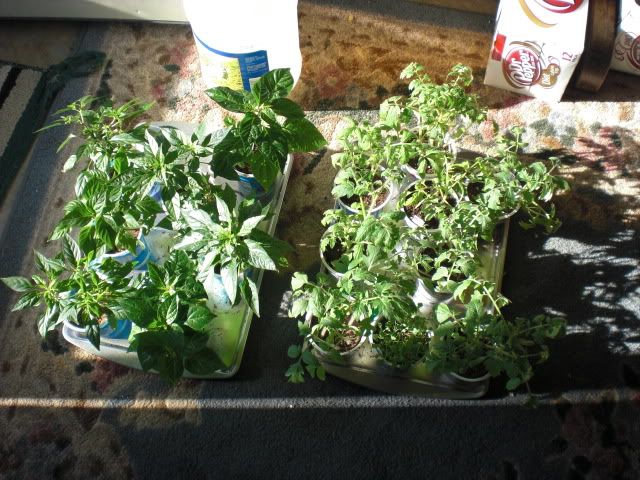Post by Rita on Feb 26, 2010 9:50:17 GMT -6
Spring Indoor Seed-starting Guide
How to use the chart below: First, estimate the date
your last spring frost is expected using the range of
dates indicated on the map on above. Record the
frost-free date it indicates for your region in the
blank space provided below these instructions.
Next, get a calendar and, for each crop, add or
subtract the number of weeks in column two, “Safe
setting-out time,” from your frost-free date. Record
these dates in the blank spaces under column
three, “Setting-out date.” This is the date it should
be safe to plant your seedlings outside.
(Remember to harden them off for a week or so
before planting them out.) Now, take each date
from column three, subtract the number of weeks
shown for that crop in column four, “From sowing
to setting-out,” and record that date in column five,
“Start indoors date.” That is the latest you should
start those seeds indoors.
For more information about your location, go to
The spring frost-free date in my garden is ___________ (based on the map above).
Safe setting-out time From Start
Fruits & relative to Setting-out sowing indoors
Veggies frost-free date date to setting-out date Seed-starting tips
Broccoli 2 weeks before _______ 4 to 6 weeks _______ Choose an early variety for your indoor planting
Cabbage 4 weeks before _______ 4 to 6 _______ Plant thinly; keep cool
Cantaloupe 2 weeks after _______ 3 to 4 _______ Presprout in a paper towel at 80 degrees and then plant carefully
in a 4-inch pot. Not a good candidate for starting in flats
Cauliflower 2 weeks before _______ 4 to 6 _______ Keep cauliflower growing steadily to ensure good heads
Cucumber 1 to 2 weeks after _______ 3 to 4 _______ Root often emerges first
Eggplant 2 to 3 weeks after _______ 8 to10 _______ Can presprout; do not withhold water while hardening off
Leek 4 weeks before _______ 6 to 8 _______ Plant out in trenches
Lettuce 3 to 4 weeks before _______ 4 to 5 _______ Cover seeds thinly, and thin to 3 inches apart in the flat
Okra 2 to 4 weeks after _______ 4 to 6 _______ Soak fresh seeds to soften coat; use deep pots for taproots
Onion 4 weeks before _______ 6 to 8 _______ Use fresh seed, start early and keep at less than 70 degrees
Pepper 2 weeks after _______ 6 to 14 _______ Keep soil on the dry side
Tomato 1 to 2 weeks after _______ 6 to 8 _______ Transplant twice, from starting flat to cell-pack, to 3-inch pots
Herbs
Basil 1 week after _______ 6 _______ Cover only lightly with fine soil
Chives 1 week after _______ 8 _______ Use fresh seed
Lemon balm 3 weeks before _______ 8 _______ Do not cover; needs light to germinate; protect from heavy frost
Parsley 3 weeks before _______ 9 to 10 _______ Presoak seed twice to speed up germination
Sage 1 week before _______ 8 _______ Keep seedlings dry
Thyme 2 weeks before _______ 8 to 10 _______ Keep soil surface dry
Flowers
Ageratum 1 week after _______ 4 _______ Do not cover; needs light to germinate
Dahlia 2 weeks after _______ 8 _______ Save tubers in fall, store in peat moss in a cold, protected place
Marigold 2 weeks after _______ 6 to 8 _______ Tall varieties and hybrids bloom earlier if started indoors
Nicotiana 2 weeks after _______ 6 to 8 _______ Do not cover; needs light to germinate; bottom water
Petunia 2 weeks after _______ 10 to 12 _______ Do not cover; needs light to germinate; bottom water
Snapdragon 1 week after _______ 10 to 12 _______ Do not cover; needs light to germinate; bottom water
Zinnia 2 weeks after _______ 6 to 8 _______ Touchy about transplanting; keep water off leaves to prevent fungus
All of the above, with the exception of slow growers such as eggplant and peppers, can be direct-sown in the garden. If you start them indoors,
you gain an earlier and sometimes better harvest. Start most seeds in a warm location (70 to 80 degrees) but move to a cooler location
(60 to 65 degrees) as soon as they sprout. Be sure all have adequate light
I found this on Motherearth news and thought it was a handy little chart
Seed Starting Chart
How to use the chart below: First, estimate the date
your last spring frost is expected using the range of
dates indicated on the map on above. Record the
frost-free date it indicates for your region in the
blank space provided below these instructions.
Next, get a calendar and, for each crop, add or
subtract the number of weeks in column two, “Safe
setting-out time,” from your frost-free date. Record
these dates in the blank spaces under column
three, “Setting-out date.” This is the date it should
be safe to plant your seedlings outside.
(Remember to harden them off for a week or so
before planting them out.) Now, take each date
from column three, subtract the number of weeks
shown for that crop in column four, “From sowing
to setting-out,” and record that date in column five,
“Start indoors date.” That is the latest you should
start those seeds indoors.
For more information about your location, go to
The spring frost-free date in my garden is ___________ (based on the map above).
Safe setting-out time From Start
Fruits & relative to Setting-out sowing indoors
Veggies frost-free date date to setting-out date Seed-starting tips
Broccoli 2 weeks before _______ 4 to 6 weeks _______ Choose an early variety for your indoor planting
Cabbage 4 weeks before _______ 4 to 6 _______ Plant thinly; keep cool
Cantaloupe 2 weeks after _______ 3 to 4 _______ Presprout in a paper towel at 80 degrees and then plant carefully
in a 4-inch pot. Not a good candidate for starting in flats
Cauliflower 2 weeks before _______ 4 to 6 _______ Keep cauliflower growing steadily to ensure good heads
Cucumber 1 to 2 weeks after _______ 3 to 4 _______ Root often emerges first
Eggplant 2 to 3 weeks after _______ 8 to10 _______ Can presprout; do not withhold water while hardening off
Leek 4 weeks before _______ 6 to 8 _______ Plant out in trenches
Lettuce 3 to 4 weeks before _______ 4 to 5 _______ Cover seeds thinly, and thin to 3 inches apart in the flat
Okra 2 to 4 weeks after _______ 4 to 6 _______ Soak fresh seeds to soften coat; use deep pots for taproots
Onion 4 weeks before _______ 6 to 8 _______ Use fresh seed, start early and keep at less than 70 degrees
Pepper 2 weeks after _______ 6 to 14 _______ Keep soil on the dry side
Tomato 1 to 2 weeks after _______ 6 to 8 _______ Transplant twice, from starting flat to cell-pack, to 3-inch pots
Herbs
Basil 1 week after _______ 6 _______ Cover only lightly with fine soil
Chives 1 week after _______ 8 _______ Use fresh seed
Lemon balm 3 weeks before _______ 8 _______ Do not cover; needs light to germinate; protect from heavy frost
Parsley 3 weeks before _______ 9 to 10 _______ Presoak seed twice to speed up germination
Sage 1 week before _______ 8 _______ Keep seedlings dry
Thyme 2 weeks before _______ 8 to 10 _______ Keep soil surface dry
Flowers
Ageratum 1 week after _______ 4 _______ Do not cover; needs light to germinate
Dahlia 2 weeks after _______ 8 _______ Save tubers in fall, store in peat moss in a cold, protected place
Marigold 2 weeks after _______ 6 to 8 _______ Tall varieties and hybrids bloom earlier if started indoors
Nicotiana 2 weeks after _______ 6 to 8 _______ Do not cover; needs light to germinate; bottom water
Petunia 2 weeks after _______ 10 to 12 _______ Do not cover; needs light to germinate; bottom water
Snapdragon 1 week after _______ 10 to 12 _______ Do not cover; needs light to germinate; bottom water
Zinnia 2 weeks after _______ 6 to 8 _______ Touchy about transplanting; keep water off leaves to prevent fungus
All of the above, with the exception of slow growers such as eggplant and peppers, can be direct-sown in the garden. If you start them indoors,
you gain an earlier and sometimes better harvest. Start most seeds in a warm location (70 to 80 degrees) but move to a cooler location
(60 to 65 degrees) as soon as they sprout. Be sure all have adequate light
I found this on Motherearth news and thought it was a handy little chart
Seed Starting Chart




 No its only one page this time
No its only one page this time  Rita...lotsa good info there
Rita...lotsa good info there 




 good info Rita
good info Rita

 I'm afraid my 'maters will be 2 foot tall by April 15th. ONE of y'all shouldda stopped me! I may wait a couple weeks and start some more in case they all get to be a tangled mess by planting time.
I'm afraid my 'maters will be 2 foot tall by April 15th. ONE of y'all shouldda stopped me! I may wait a couple weeks and start some more in case they all get to be a tangled mess by planting time. ( I think)
( I think) 
